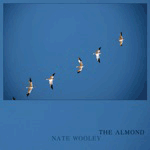|
|
 |
Dusted Reviews
Artist: Nate Wooley Album: The Almond / [8] Syllables Label: Pogus / Peira Review date: Feb. 29, 2012 |

|
|
|
 |
Listening to these two recent solo trumpet projects by Nate Wooley made me think back to around 2000 when Franz Hautzinger’s Gomberg for quarter-tone trumpet on Grob, Greg Kelley’s Trumpet on Meniscus, and Axel Dörner’s solo release on A Bruit Secret came out in relatively close proximity to each other; all of which, if not reinventing the trumpet, certainly re-invigorated an interest in the instrument. Sure, masters like Bill Dixon and Toshinori Kondo had released strong solo statements before this, but here were some new voice with prodigious technique who embraced the process of constructing advanced forms from the elemental sounds of breath and brass. Wooley’s first solo release, Wrong Shape to be a Story Teller, came out a few years later, providing ample evidence that he was another vital voice to keep an eye on. Since that release, Wooley has used the solo setting to meld pure acoustic playing, amplification, processing and tape constructions in order to develop projects of singular vision. These two recent projects are stellar examples of this musical process.
A 25-minute excerpt of his piece The Almond was offered for download on the Compost and Height website two years ago, providing an opportunity to experience this engulfing work. With this release on Pogus, one can now hear the full 72-minute realization of this lushly layered orchestral construction. In the liner notes, Wooley states that “The piece is made only of trumpet tones, no extended technique, no processing,” which may be true, but in no way prepares the listener for the harmonic opulence of what is to come. Digging in to the mechanics of the piece, Wooley explains that: “There are 10 major loops running throughout the whole piece. Within each of those large loops there are three to five smaller loops that have an element of silence. Within those smaller loops there are four to 10 smaller loops with silence and made up of the basic harmonies that move in and out. Each note of those harmonies are made up of three to six different recordings of each single pitch, using different mic techniques, room sounds, and mutes.” The result is an immersive experience (and he rightfully suggests that this one be listened to loudly), as the loops of buzzing and quavering tones accrue into coursing layers of sound.
It is easy to flip to shorthand and describe the piece as a modulating drone, but there’s far more at play here. Wooley has meticulously charted the flow and density of the piece, building upon a simple harmonic center that provides a continuous thread while transforming the resulting overtones through the use of sumptuous striations that ebb and flow throughout. The nature of the loops amassing on each other creates a sound that brings to mind a huge pipe organ, and one quickly loses track of the fact that a trumpet is at the root of the music. At other times, there are shades of a vocal choir, particularly as the densities begin to disperse at the end of the piece. Wooley eschews simple structures of arc and trajectory, instead depending upon the pulsating interactions of the overlapping sounds to develop eddies of activity, which get woven in to the immersive mix. Doubtless, hearing this one on a deluxe sound system would reveal even more richness in the detail.
Wooley’s [8] Syllables is far more raw in sound, while no less structured in process and execution. Here, he created scores for a series of sounds utilizing a graphic representation of the International Phonetic Alphabet (IPA). This was employed to create parameters of attack, body and decay of each sound. Wooley laid out groupings of similar phoneme symbols to define the deployment of traditional trumpet technique. He explains that “the idea has never been to control the elements of the embouchure, mouth, throat, tongue, et al., but to allow them to operate in an environment of their own, separated from their typical roles in the production of sound; essentially to set up a machine and let it run on its own, with no results based judgment of the resultant product.” In this process, the core kernels of spoken language are transposed to define the structural form.
The piece is broken in to sections separated by silence, with each section structured around the manipulation of the prescribed technique repeated for a specific number of breaths, a concept Wooley appropriated from James Tenney. While Wooley describes the generation of sound as “the machine,” it is his spontaneous integration of techniques established over years of playing, injected with the rudiments of techniques used to vocalize language, that sparks this piece into something beyond mere exercise. The choice of location for the recording also comes in to play; the live reverberance of the ISSUE Project Room adds yet another layer of nuance to the performance. What could come off as dry and formal is anything but as Wooley’s pinched tones, splayed flurries, hisses, shreds, scrapes, yelps, growls and groans are transformed into circuitous trumpet lines that gather force and momentum and then break into dramatic pause. Here, bereft of amplification, processing, or tape treatments, the recording captures him as he builds a transmogrified language for performance.
By Michael Rosenstein
|







